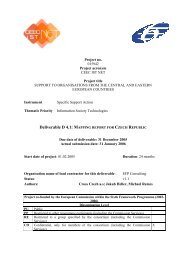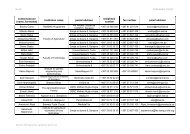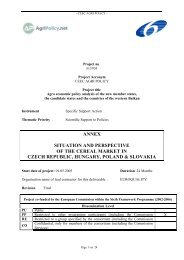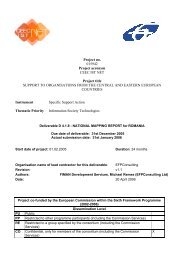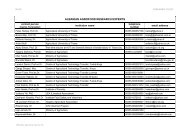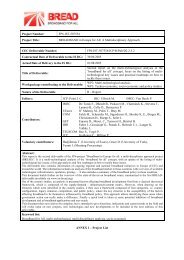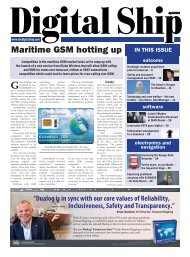Project Number: FP6-IST-507554 Project Title: BROADBAND in ...
Project Number: FP6-IST-507554 Project Title: BROADBAND in ...
Project Number: FP6-IST-507554 Project Title: BROADBAND in ...
You also want an ePaper? Increase the reach of your titles
YUMPU automatically turns print PDFs into web optimized ePapers that Google loves.
Page 44 of 319<br />
<strong>FP6</strong>-<strong>IST</strong>-<strong>507554</strong>/JCP/R/Pub/D2.2-3.2<br />
Another important issue of cable network is the <strong>in</strong>terconnection of HFC networks <strong>in</strong> hybrid <strong>in</strong>frastructure.<br />
Connection with a broadcast media is not required, as HFC network supports broadcast services, but the<br />
<strong>in</strong>terconnection of HFC the follow<strong>in</strong>g networks is required:<br />
• Mobile networks to provide subscriber and session mobility between the cable and the mobile network<br />
• Wireless networks like WIMAX to cover non-cabled areas<br />
Different alternatives to fulfil the requirements of future HFC networks are developed <strong>in</strong> annex 2:<br />
On the <strong>in</strong>frastructure side, different paradigms can be developed to <strong>in</strong>crease the network capacity, the ma<strong>in</strong><br />
ones be<strong>in</strong>g:<br />
• Keep analogue transport <strong>in</strong> the fibre part of the network and a centralised architecture (routers are<br />
placed <strong>in</strong> a Local Node)<br />
• Upgrade the fibre network to digital transport <strong>in</strong> a decentralised architecture where the routers (CMTS)<br />
are serv<strong>in</strong>g small subscriber areas (50-200)<br />
• Hybrid <strong>in</strong>frastructure with analogue transport for broadcast services and digital transport for <strong>in</strong>teractive<br />
traffic.<br />
Higher capacity downstream and upstream will require the def<strong>in</strong>ition of more optimised physical and MAC layer<br />
standards adapted to these architectures:<br />
• Much higher peak bit rate downstream (> 200 Mbps) and upstream (> 100 Mbps)<br />
• Capacity to manage efficiently the resources between video, voice and data traffic<br />
• Load balanc<strong>in</strong>g between downstream and upstream channels<br />
On the security and content protection aspects, converged VOIP and data frameworks have been def<strong>in</strong>ed<br />
with<strong>in</strong> Packet Cable and Packet Cable Multimedia, allow<strong>in</strong>g significant cots sav<strong>in</strong>gs. This must now converged<br />
with the video security framework, and mobile security frameworks to enable seamless access and mobility.<br />
Different solutions com<strong>in</strong>g from DVB, OMA, MPEG21, have now to be def<strong>in</strong>ed, <strong>in</strong>tegrated and set-up.<br />
Different paradigms from full system def<strong>in</strong>ition and standardisation (like OMA) to the def<strong>in</strong>ition of<br />
<strong>in</strong>teroperable <strong>in</strong>terfaces between different security systems (<strong>in</strong> the cont<strong>in</strong>uation of DVB-CA activities).<br />
The operator has to analyse how to extend its doma<strong>in</strong> to the home network on the follow<strong>in</strong>g aspects:<br />
• End to end quality of service<br />
• Security<br />
• Mobility (session mobility and user mobility), seamless handover<br />
This implies the def<strong>in</strong>ition of boundaries and the related <strong>in</strong>terfaces between the home and the cable network, and<br />
also the management and provision<strong>in</strong>g of home network devices. A first example (but not yet deployed)<br />
example of such architecture is CableHome (see annex 2).<br />
A second example of <strong>in</strong>vestigation is the usage of cable network <strong>in</strong> the home to convey broadcast and <strong>in</strong>teractive<br />
AV services, and to <strong>in</strong>terconnect WLANs <strong>in</strong> the home.<br />
Besides security, the IP architecture framework <strong>in</strong>clud<strong>in</strong>g signall<strong>in</strong>g, QoS, devices provision<strong>in</strong>g, charg<strong>in</strong>g has<br />
to evolve to <strong>in</strong>clude video and broadcast services, and to ensure a convergent architecture with mobile networks.<br />
Packet Cable and Packet Cable Multimedia are a good basis for this evolution, to cope with multiple signall<strong>in</strong>g<br />
schemes (<strong>in</strong>clud<strong>in</strong>g SIP and RSTP), and multicast/broadcast support. Instead of def<strong>in</strong><strong>in</strong>g signall<strong>in</strong>g schemes, the<br />
tendency is more to def<strong>in</strong>e cross layer <strong>in</strong>terfaces between application layer devices and network layer devices.<br />
This ensures an openness and clear separation between network, services and applications. Therefore an<br />
evolution of current packet Cable multimedia architecture to support triple play appears to be the logical trend.<br />
This also allows to <strong>in</strong>terconnect easily fixed and mobile networks for QoS admission and control purpose. The<br />
other aspects of fixed mobile convergence are related to a more general framework <strong>in</strong>dependent of cable.<br />
Hybrid <strong>in</strong>frastructures like HFC/W <strong>in</strong>frastructures with wireless cells are desirable to provide an optimal<br />
<strong>in</strong>frastructure. Beside a common IP archtitecture, and common provision<strong>in</strong>g mechanisms, common MAC layer<br />
can be imag<strong>in</strong>ed as well as the medium have identical po<strong>in</strong>t to multipo<strong>in</strong>t topologies.



